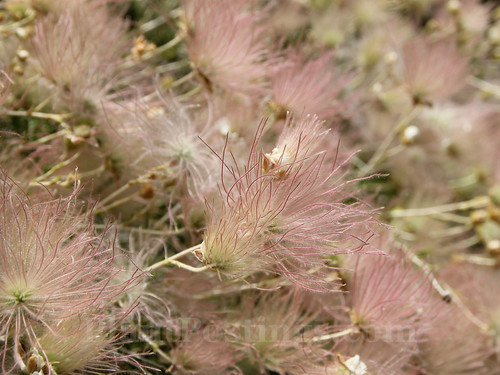
I'm just returning from an extended road trip to the Four Corners region of the Southwest U.S.--where New Mexico, Arizona, Utah, and Colorado meet. Of course, this "plant nerd" had to photograph a few growing things along the way.
One, in particular, that caught my eye was a unique shrub with fluffy seedheads: Apache Plume (Fallugia paradoxa). It's the only species in its genus.
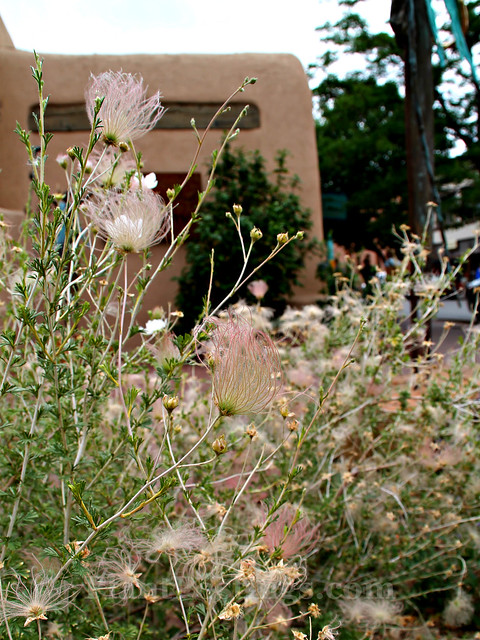
We saw it in Santa Fe, New Mexico, where its rosy glow nicely framed the local pueblo-style architecture.
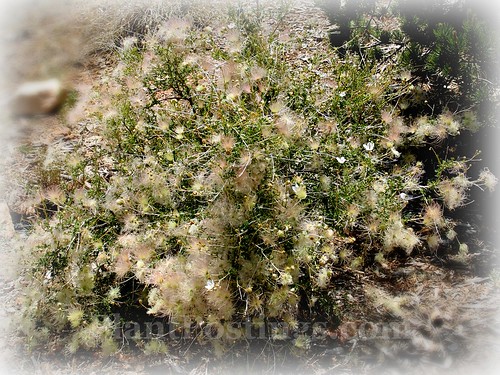
And at Grand Canyon National Park in Arizona, where the shrubs were plentiful along the paths, blending naturally with their surroundings.
Apache Plume is native to only eight U.S. states--California, Nevada, Utah, Colorado, Oklahoma, Texas, New Mexico, and Arizona, as well as Northern Mexico. If I lived in one of those locations, I would plant one or more. Thing is, it has a very specific preference for dry, rocky locations. In good garden soil with organic matter, it can look rangy and produces fewer flowers, according to Texas A&M University.
I'm thinking this is not a plant for most temperate gardens, but best enjoyed in its native setting.
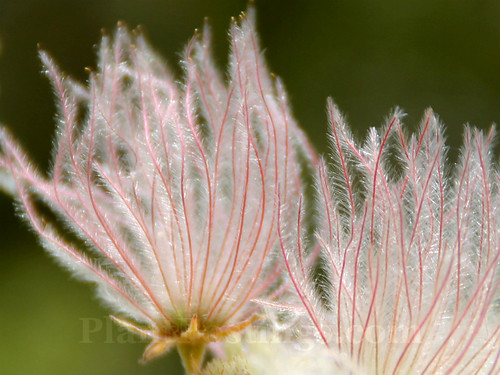
From a distance, Apache Plume resembles a Smokebush (Cotinus) cultivar, but its seedheads/fruits are very similar to those of its cousin in the Rose family, Prairie Smoke (Geum triflorum).
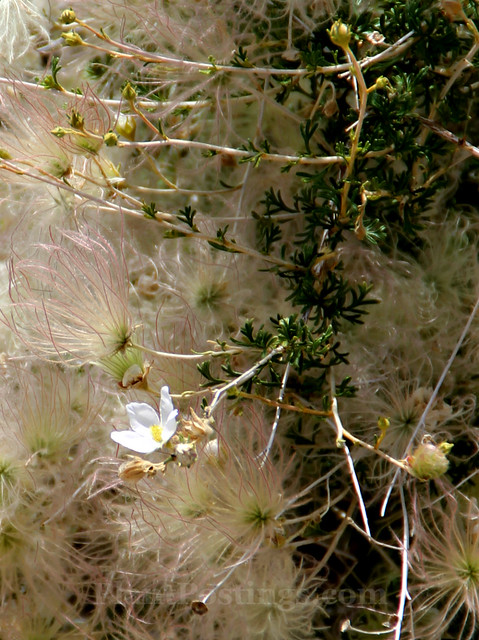
The small white flowers resemble related blooms in the Rose family. When the petals drop, the feathery achene fruits/seeds puff out, giving it a soft, fluffy appearance. It's the kind of seedhead you want to touch, and it's very soft.
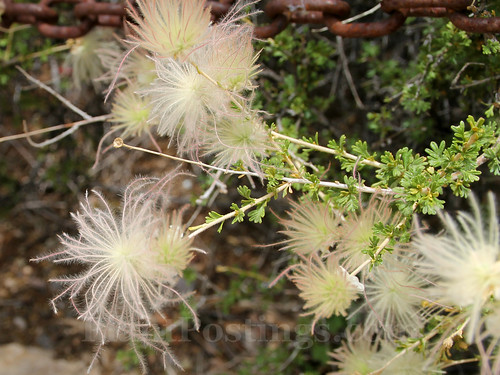
The foliage is semi-evergreen; small, deeply lobed leaves along slender, twiggy branches. Among the many Apache Plume shrubs we saw during the trip, the seedhead colors ranged from a creamy white to a lovely rose-pink.
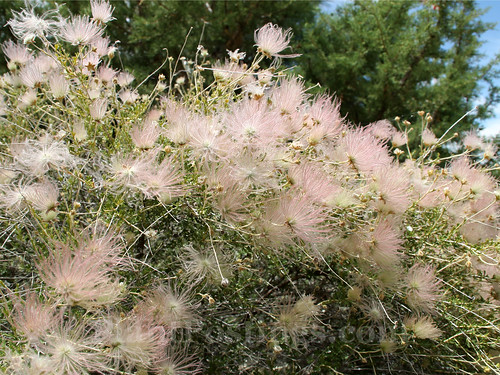
The plumes are very attractive with bright light shining through their filaments.
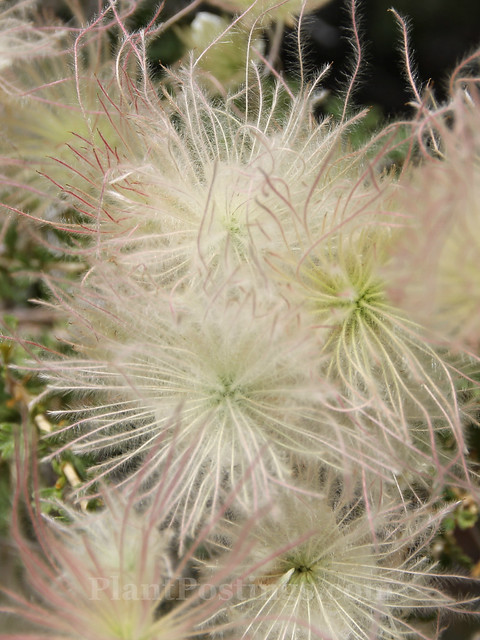
Go ahead: Try to resist touching those soft, powder-puff plumes!
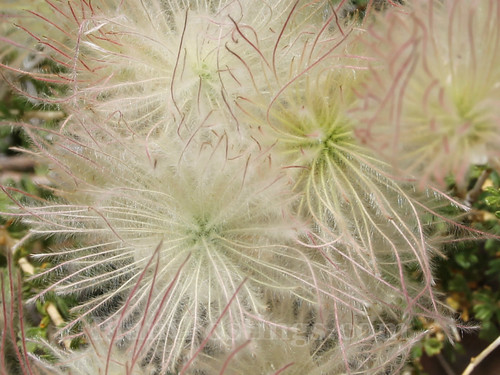
Apache Plume is hardy to zone 5, but, again, best-suited to its native habitat in the Southwest U.S. It grows to 6 ft. tall and wide, according to the Lady Bird Johnson Wildflower Center. It grows in part shade to full sun, and is a good choice for a xeriscape garden.
Historically, its branches were used for sweeping and its steeped leaves for tea and hair-washing. In its dry, rocky native habitat, it's an important forage and cover plant for wild animals and a nectar source for pollinators.
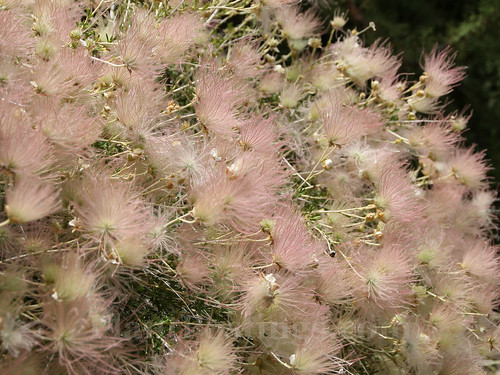
At its peak display, it looks soft enough for a pillow ...
(Linking this post to Dozens for Diana.)
It's a gorgeous plant and, as you noted, best enjoyed in its native habitat. I live just east of its native range and tried growing it for a while on my sunniest rocky limestone slope and it never did well before dying off in a wet spring.
ReplyDeleteYeah, it seemed so happy in the dry, sunny Southwest. Kind of the opposite of the conditions I have here--except during an extended drought, which I hope won't happen again for a very long time. But, with that said, if I lived within its range, I would definitely plant a couple of these.
DeleteAmazing photos of un for me unknown plant.
ReplyDeleteThank you--it was unknown to me before, too.
DeleteOne of my favorite plants. Absolutely gorgeous in West Texas and New Mexico, as your photos certainly demonstrate. I've seen it in Austin, but it has to be in just the right spot. Alas, my soil is too heavy and my conditions too shady Great post.
ReplyDeleteThanks, Tina. Yes, I can see how it would like West Texas. I remember the conditions of the Big Bend National Park area from a trip there many years ago. I probably saw Apache Plume when we were hiking there, and didn't really notice it or think about it much. We were with friends and preoccupied, and it was a long time ago. Some of the shrubs at the Grand Canyon area were better maintained than others. It seemed to benefit from a little shaping and trimming.
DeleteHi,
ReplyDeleteI agree, best enjoyed in its native habitat. I like the look of it. The first thought of mine was it looked like a pillow. :-)
Carla
Yeah, I had to touch the plumes. There was no way I could stop. ;-) And then the camera came out, and I got a little carried away. If I hadn't had other plans, I would have gone way overboard with the photos of this plant.
DeleteThis is a cutie. I loves those fluffy blooms.
ReplyDeleteYes, cutie is a good way to put it. Especially the shrubs that were a little more shaped and maintained. Such a soft, ethereal effect. It wouldn't work in a lush, moist garden, but it seemed very happy in the dry, sunny Southwest.
DeleteGreat pictures Beth. This plant certainly has an interesting form. No wonder it drew your attention. Always wanted to visit Four Corners.
ReplyDeleteThanks! Yes, I kept seeing it in various locations and then did a little research to find out what it was. I definitely recommend a Four Corners tour. Wish we could have spent a little more time in Utah (and the other three states, actually), but it was fun to see many of the highlights.
DeleteOh! I looked at that and thought Prairie Smoke. Nice to have a couple of garden-friendly alternatives to achieve that sort of effect.
ReplyDeleteIt is what I would have liked from my sadly sulked off Phylica.
Would love to have some happy feathers in my garden, one day.
I know: I realized it had to be related to Prairie Smoke. Love those plumes on both plants! Apache Plume is a happy plant in its natural setting, but I have the feeling it's a little finicky outside its range.
DeletePS good timing - my Dozen for Diana went up today, early this month.
ReplyDeleteThanks for hosting, Diana. :)
DeleteLovely to hear about, lovely to see, lovely that I don't even have to think about growing it.
ReplyDeleteYes, I'd have to agree. I prefer a lush, green, fertile landscape for a garden. But, in the right setting this shrub is lovely.
DeletePretty color plumes and it loos very soft. Big though, not a likely for a home garden I suspect.
ReplyDeleteThe size seemed to vary quite a bit. Many were 3X3 or 4X4--I guess after a little shaping and pruning. The ones that were better maintained were more attractive, too. I think it would work well in a home garden--but only in its native range.
DeleteIt is beautiful, especially at close-up. I wonder why it has those long supposedly petals? I don't know what part of the flower are those. On second thoughts they could be bad for people with allergies.
ReplyDeleteThe plumes are part of the fruit or seed. They catch the wind later in the season and help to disperse the seeds. I don't know if they would be allergenic. Possibly, but I think pollen of various plants is usually more of a problem.
DeleteI was thinking of Prairie Smoke the minute I saw these blooms. They do tempt you to reach out and touch them!
ReplyDeleteI know: I thought of it right away and found out they're both in the Rose family. I love the seedheads of both plants--very soft and whimsical. :)
DeleteAnother completely new-to-me plant, how lovely. Definitely looks soft and fluffy. I've been to the Four Corners region decades ago but I don't remember seeing these beauties. I can't wait to see more photos of your trip!
ReplyDeleteIt had been a while for me, too. Great fun to visit some of these amazing places again! Apache Plume is a nifty plant, indeed.
DeleteI too had neither heard of nor seen this one before...which for me isn't altogether unusual, I suppose ;)
ReplyDeleteI hate to throw anything away in general, so I always enjoy hearing about how various parts of a plant were used, especially when it's something unusual such as using the branches for sweeping. I could see myself trying that if I had one of those in my garden. And yes, I wouldn't be able to resist touching them :)
Yes, I had to touch the plumes and they were so soft! I know--it's fun to learn about the uses for plants over time. :)
DeleteWhen this popped up in my inbox, I thought 'Oh, is that smokebush?' (as there's one in a local arboretum), but no, it's a new-to-me plant too! It's lovely. I'm quite fond of seed heads and your photographs show such detail and how it gets prettier the closer you get.
ReplyDeleteI have a fascination with seedheads, too, increasingly for some reason. This plant seems to look best when it's trimmed and maintained. It's easy to miss from a distance, but it's stunningly beautiful when you see the detail on closer inspection.
DeleteI love seeing and learning something new . . .
ReplyDeleteApache Plume made my day . . .
Beautiful . . .
Oh, I'm glad you enjoyed it. Yes, I love to see and experience new things, too. :)
DeleteYes, I agree it looks like a wonderful plant ... for its native setting!
ReplyDeleteBut thanks for sharing some pics for those of us who haven't had the pleasure of seeing it in person :)
You are welcome. Indeed, I wouldn't even begin to try this plant in an average temperate garden. But it seems like a great addition to a xeric garden in its native range.
DeleteVery interesting Beth. I used to grow Prairie Smoke but it seems to have disappear.
ReplyDeleteI love Prairie Smoke! Now that is a plant that grows well in a wide swath of North America. I think it needs more sun than I can give it here, however.
DeleteWhat a fascinating plant, thank you for the introduction. Amazing to see something so reminiscent of Prairie Smoke in such a large plant!
ReplyDeleteYou are most welcome. I agree--when I first saw it close up I thought, "What? A Prairie Smoke shrub?" Then I saw a label for it at the Grand Canyon National Park, which helped with my research. :)
DeleteWhat a lovely plant...
ReplyDeleteAmanda xx
It is. I think we saw it at its most interesting stage, too, with the seedheads fluffy and puffed out.
DeleteHi Beth, It sounds like you had a great trip! What a lovely plant. I can understand why you looked into how to grow it......I especially loved the last picture. Happy Gardening!
ReplyDeleteYes, it was a wonderful adventure ... or adventures, should I say? I'm glad you enjoyed the images. Happy gardening to you, too!
DeleteOH is that not MAGICAL!!!!!!!!!!!!!!!!
ReplyDeleteWe have to travel in order to experience the array of possibilities that the earth provides for us to witness. I've only seen our SMOKE tree that resembles this, and the other day, I did not have my camera to capture the very similar puffs that had DEW on them after the storm. These pink puffs resembled cotton candy. I think my husband got a shot and I need to view these photos.
Your shares are gorgeous, such light pink delicacy! Thank you so much for coming into my Minneapolis urban garden dear friend!
Yes, travel does expand the worldview, doesn't it? I love to travel, but I love to get home afterward, too. ;-) Oh, I hope your hubby got some pics of the dew on the smoke tree--that must have been beautiful! Cheers!
DeleteI love the blooms on this plant and it looks right at home in its native habitat. I do have some very dry, rocky locations but not sure it would take our humidity. I have enjoyed your photos from your trip. Looking forward to seeing you this week at the Fling!
ReplyDeleteI'm looking forward to the Fling, too! Can't believe it's this weekend! Ya, I don't think this plant would survive long in either my garden or yours. But if/when you visit the Southwest, you're likely to see it. :)
DeleteWhat a great looking plant. Nothing like a new environment to thrll and educate us. Thanks to your post about The Ridges in Door Co. we went there on our recent trip.
ReplyDeleteI'm glad you enjoyed The Ridges, Linda. It's a magical place, and a gem of our fair state. :) Yes, travel is wonderful, but it's so nice to be back home again, too.
DeleteI love it! Such an unusual seedhead! They look so very familiar somehow to me. I wonder if I saw some when I lived in Utah years ago. Either that or they are reminding me of clematis seedheads.
ReplyDeleteHi Indie: I suppose that's highly likely you saw them in Utah. I wish we'd had more time to explore Utah. We stepped on a corner of it, but spent most of our time in New Mexico, Arizona, and Colorado (and the other states along the way). Oh well, a good reason for another trip! :)
DeleteSo nice to see Apache plume! I know it from when I lived in southeast Arizona. And beautiful photos, especially of the seed tails. thanks for the memories :-)
ReplyDeleteThanks, Hollis. Yes, this is an unusual, beautiful plant. Southeast Arizona--that must have been a much different experience from Wyoming!
DeleteNeat looking plant... Thank you for the supportive comments on my blog.. It is appreciated very much.. Michelle
ReplyDeleteYes, it's a beauty and perfect for its unique habitat. You are most welcome, Michelle. I enjoy your blog immensely, and I hope your neighborhood issues will be resolved peacefully. Best wishes always, and thanks for your kind comments here, too. :)
DeleteIt's so much fun to travel to different climates and see both what's similar and different from what we have! My kids know that whenever we travel, I'm going to stop and take pictures of the plants! In fact, even when they travel without me, they will take pictures of gardens and send them to me! That's a really pretty, interesting shrub!--Kimberley
ReplyDeleteIndeed! Yes, learning about new plants and photographing is one of the great joys of travel! Nice that your kids do that for you, too. :)
DeleteWhat a pretty plant - both up close and as a little bush!
ReplyDeleteThe seed heads almost look like fragile sea anemones.
Thanks for sharing something new :)
You are welcome. Yes, it is very pretty--understated, but gorgeous in its simplicity. Plus, the seedheads are so soft!
DeleteWhat a pretty bloom!
ReplyDeleteThe blooms are nice--they look like small rose or apple blossoms. But the seedheads are so unique. :)
Delete